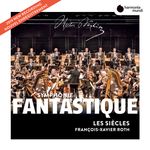|
Back
02/06/2020
Hector Berlioz: Symphonie fantastique, opus 14, H. 48 – Les Francs-juges, Ouverture, opus 3, H. 23
Les Siècles, François-Xavier Roth (conductor)
Recording: Maison de l’Orchestre national d’Ile-de-France, Alfortville, France (July 16-17, 2019) – 65’49
harmonia mundi HMM 902644 (Distributed by PIAS) – Booklet in French, English and German

   
François-Xavier Roth rules with an iron fist when it comes to performing classics, and, importantly, these two Berlioz inventions. Along with his creation of Les Siècles in 2003 comes a ‘full reality check of the past’, utilizing ‘period instruments’ including the ophicléide and a Stephan Berger serpent with one exception being the bells of La Côte-Saint-André that were casted for the Berlioz Festival in 2013. On that note, the overall vibe has an unmistakable glean with spot-on detail...these Berlioz pieces simply resonate.
Berlioz’s wildly episodic “life of an artist” logically commences with imbued vagaries during the passions entrée that come and go like metals fines subjected to a U-magnet’s oscillating field. At the get-go François-Xavier Roth intelligently manipulates sforzando with arresting display. This Symphonie fantastique isn’t completely pre-determined, rather, there's an enigmatic charge that takes over, brilliantly whittling away on a whim while toying with the mind. Tease, if you will, but more stridently, hallucinogenic. Strings’ razor-remarks are light, in part due to the incorporation of cordes en boyaux: tones fully consume with transparent vibrancy.
“Un bal’s” strengthening portamento along with four Erard-style harps add to its lilting cadences. Though Berlioz added cornet to his autograph score, the instrument was not included in the published score; however, M. Roth honors the obligation. Even though brass is missing, it’s an enviable asset since the movement isn't dampened, maintaining a more dignified level of butyraceous sophistication.
The “Scène aux champs’” echoed tête-à-tête has tremendous loftiness as heard by Stéphan Morvan’s cor anglais and Hélène Mourot’s distant oboe, especially since the acoustics are far-reaching. The chat is an idyllic charmer. The bucolic ranz des vaches melody, though warming, seizes the notion of uncertainty that M. Roth greatly capitalizes upon. Suddenly, the intimate dialogue is severed by timpani, leaving the English horn in isolation to grapple with the situation. Orchestrally and colorfully charged, it generates an emotional paranoia on several fronts... M. Morvan is left without companion.
Cellos knock at the artist’s door during the “Marche au supplice”, hinting at doubts of survival. Catapulting on both ends of the scale and sizeable mobility, Maestro Roth rolls back the tempo a notch, nestling him inside one of his best moments...the quixotic, the impulsive, the wavering, the uncertainty abound. He doesn’t ‘over-think’. All prognostications neatly gnaw away with friction which catapult the listener into a state of shocking tumult. Sickly fabulous!
Swirling and convoluting, François-Xavier Roth converses and digests the artist’s ultimate demise during the “Songe d’une nuit du sabbat”: the B-Flat clarinet (1’42) squeaks vulgarity with a sharper response by the E-Flat clarinet to follow. To the delight of the brass (8’32), the Dies irae is re-unveiled, opening the door to clarion doom. Those penultimate bars netting the strings’ impeccable col legno battuto attract a flurry of trilling woodwinds detail...this is where M. Roth presses the piece into an eerie climax and an ebullient horn flush.
Berlioz’s unfinished opera, Les Francs-juges, went on to become a stimulating overture, and the first work the composer wrote for full orchestra. M. Roth’s leading remarks are patient to open into a broody flood of brass and the eventuality of foreboding strings (3’53). The structure, surging forth in Auber positioning, doesn’t hesitate as the orchestra paves a pathway to amenability (4’45) despite the work continuing to simmer in unsettlement and recalls of Cherubini’s militaristic theatrics. Exemplified by strings, the nagging mayhem whips up frothy cello white caps, swirling into a patriotic eclipse (9’57) initiated by basson/ophicléide jabs. This emits upper pizzicato sprints with an unarguable revolutionary-taunting tour-de-force. Daring to dwell for a moment upon the futuristic “Marche au supplice”, Maestro Roth whips away to a finish line of concentrated Auber dénouement.
François-Xavier Roth has made it a point to ‘sharpen his pencil’ and to further understand the retouches whirling around the Symphonie fantastique since its inception. After the first recording in 2009, Les Siècles is now back with another jeweled visit, and the depiction could be one of the best ever. Enthralling and majestic.
Christie Grimstad
|